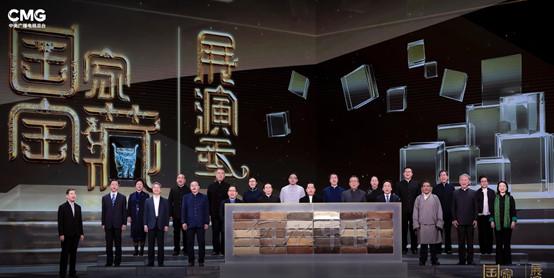The "National Treasures Exhibition season" of the Central Radio and Television Corporation has officially concluded a few days ago. Curators from 30 exhibiting museums across the country gathered to unveil the special exhibition of national treasures.

Thirty curators also brought "Thick Earth Cubes" collected from important local archaeological sites to jointly build the "Why China" installation on the spot to launch the special exhibition. Xiao Haiming, director of the Guangdong Provincial Museum, collected soil from the Shixia Site in Qujiang District, Shaoguan City, Guangdong Province, an important archaeological site in South China, and participated in the launching ceremony of the special exhibition with the precious cultural relics "Tang Monks Taking Sutras and Pillows".
From 1973 to 1978, three archaeological excavations were carried out at the Shixia site in Qujiang District, Shaoguan City, Guangdong Province, and a large number of remains such as house sites, ash pits and kiln sites were found, 132 tombs were cleaned up, and more than 10,000 artifacts of various types were unearthed. These findings provide extremely important and typical physical materials for studying the cultural connotation, chronology and relationship with other cultures from the Neolithic to the Bronze Age in Guangdong, and for exploring the social and historical issues such as the disintegration and phased development process of primitive society in China, and are also important physical evidence for exploring the social and cultural development of Lingnan from primitive society to before the Qin and Han dynasties. The site was rated as one of the 100 major archaeological discoveries in China in the 20th century, and is an important harvest of archaeology in South China.
It is worth mentioning that the precious cultural relics of the Guangdong Provincial Museum, "Tang Monks Taking Sutra Pillows" and "Song Jinxiang Ornaments", will be exhibited in Beijing.
"Tang monks take the scriptures and pillow" is a representative work of the Cizhou kiln in the Yuan Dynasty. This porcelain pillow is not only a practical object of daily life, but also an extremely exquisite ceramic handicraft. Paintings and decorative motifs have both the characteristics of flower and bird paintings and the depiction of folk mythological stories. In particular, the story of the Tang monks drawing on the pillow provides valuable information for the study of the writing process of China's famous mythological novel "Journey to the West". The theme of the Tang monks taking the scriptures appears on the paintings of the porcelain pillows of the Cizhou kiln, indicating that the story of the sutra collection at that time had been widely circulated. On the picture, Sun Wukong has not yet worn a tiger skin skirt, the Eight Precepts of the Pig have not yet had a big belly and no luggage; the sand monk is holding an umbrella, not holding a treasure staff. These are still some distance from the images in the Journey to the West written by Wu Cheng'en in the Ming Dynasty, which reflects the storyline and character images of the Tang monks after the Yuan Dynasty. This is one of the early images of the Tang monks' sutras that have survived to the present day, which not only reflects the superb artistic achievements of folk porcelain painters, but also is a reference-worthy physical evidence for studying the history of the novel "Journey to the West".
The Song gold necklace is woven from four strands of eight gold threads and has a square cross-section. The hook is a long strip with a raised middle and pattern, with four small rings at one end that can be used to adjust the elasticity. As the first gold vessel to emerge from the Nanhai I shipwreck, its craftsmanship is not in the traditional Chinese style, suggesting that the wreck may be related to overseas trade activities.
Text/Guangzhou Daily Xinhuacheng reporter Bu Songzhu correspondent Huang Suzhe
Photo/ Courtesy of Guangdong Provincial Museum
Guangzhou Daily New Flower City Editor: Xie Yufen